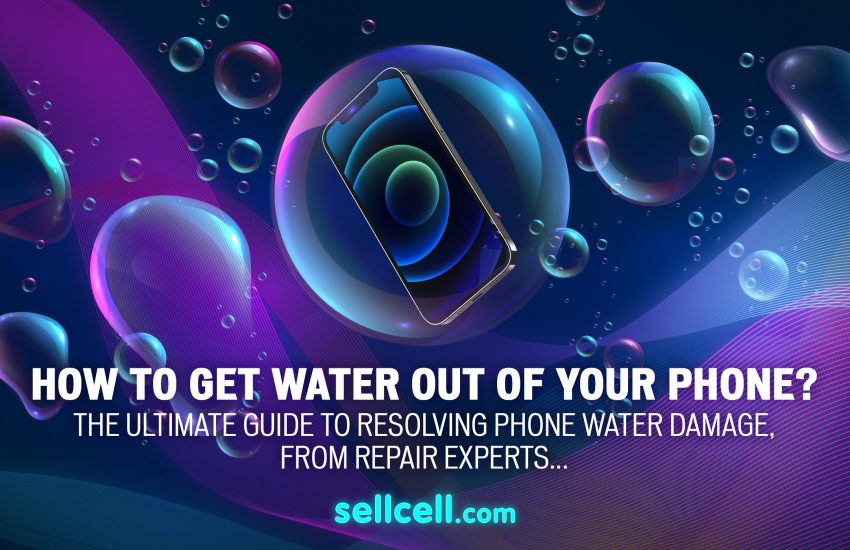Last updated February 22, 2024
The ultimate guide to resolving phone water damage, from repair experts…
This article will discuss how to get water out of your phone if it experiences water damage. It will give you some hints and tips on how to dry your phone out if it gets water inside it, what you MUST NOT do if your phone ends up with water damage, and who you should turn to in order to get a water damaged phone fixed.
Water damage is one of the most catastrophic occurrences when it comes to your smartphone. Leave it too long, and you risk losing your handset entirely, so you need to know how to get water out of the handset the second you notice it is wet.
Read on to find out what to do if you get water inside your phone.
What Is Water Damage in a Phone?
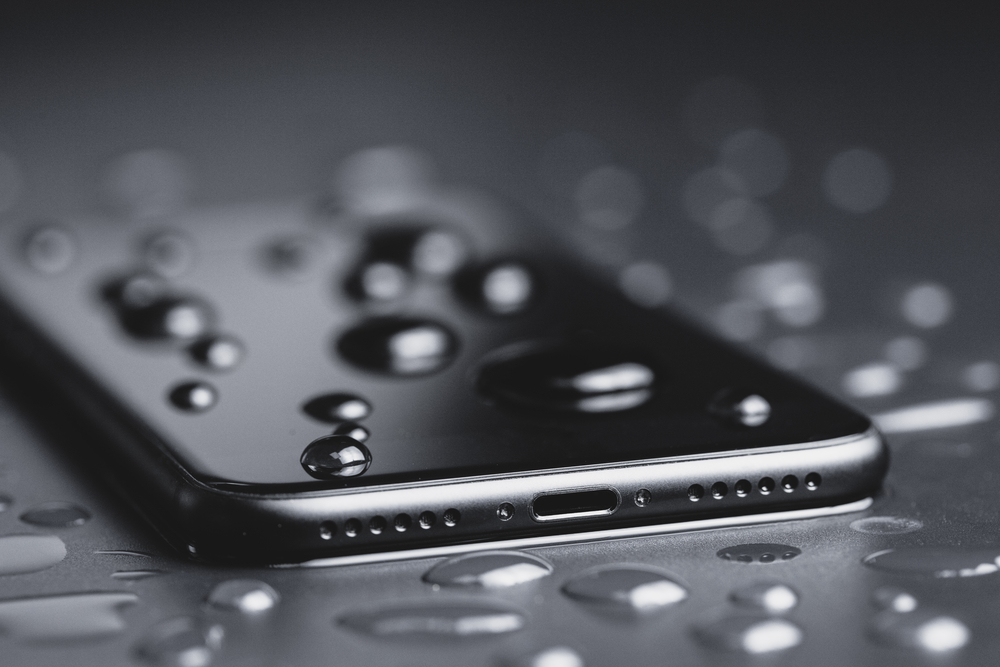
Water damage in a phone refers to the harmful effects caused when liquid, typically water, enters the internal components of the device. This can occur when a phone undergoes exposure to water, through accidents such as dropping it in a pool, spilling a drink on it, or even getting caught in the rain. When water enters a phone, it can lead to various issues such as corrosion of the circuitry, malfunctioning of buttons or touchscreens, and damage to the battery (which might then go on fire if it short circuits). These problems can result in the phone becoming unresponsive, unstable, or completely unusable.
Water damage can come from numerous liquids, not just tap water, and is often also referred to as liquid damage. If you expose your phone to tea, coffee, sea water, river water, fizzy drinks (imagine the damage the world’s most famous Cola could do to your phone), toilet water, you name it, that liquid is going to damage your phone.
SellCell’s COO Sarah McConomy (who also co-founded a leading repair company), indicates that salt water can be more corrosive and can accelerate the corrosion of internal metals, so needs to be dealt with urgently. Saltwater can actually be five times more corrosive than freshwater.
If you find water damage inside your phone, it is crucial to act quickly to minimize the potential harm. One method to help reduce the damage is to follow the steps below on how to get water out of your phone. However, it is important to note that these steps may not always be effective, and it is advisable to seek professional assistance or consult the manufacturer’s guidelines for your specific phone model.
What Happens to Your Phone if it Is Exposed to Water?
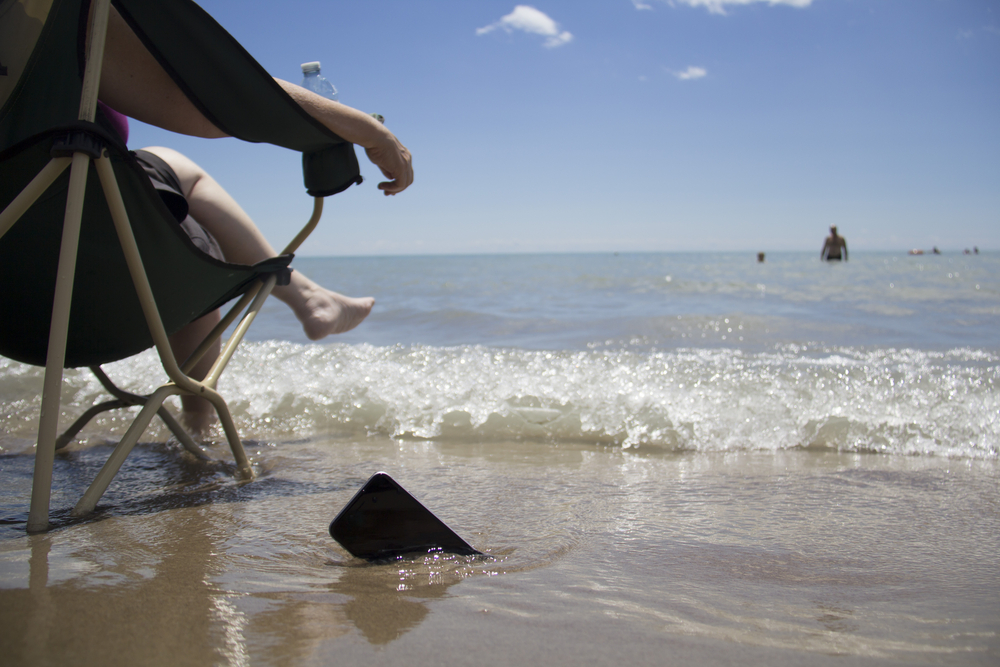
When you expose a phone to water, several potential consequences can occur depending on the severity and duration of exposure. Water ingress, which is when water enters the phone’s internal components, can lead to various issues. If you don’t sort water ingress quickly, the following outcomes may occur:
- Malfunctioning or non-responsive screen: Water can cause the phone’s screen to become unresponsive or display erratic behavior. This is because water disrupts the electrical connections between the screen and the phone’s circuitry.
- Short circuits: Water can create short circuits in the phone’s delicate circuitry, leading to the malfunctioning of various components. This can cause a complete loss of functionality or sporadic issues, such as random reboots, freezing, or a non-functional phone.
- Corrosion: When water comes into contact with the metal components inside the phone, it can cause corrosion. Corrosion gradually damages the internal parts, including the motherboard, battery connectors, and other vital components. Also, corrosion weakens the connections and can render the phone inoperable.
- Battery damage: Water exposure can damage the phone’s battery. It may lead to reduced battery life, inability to hold a charge, or even swelling and leakage, which poses a safety risk.
- Data loss: If water reaches the phone’s storage components, such as the internal memory or SIM card, it may cause permanent data loss. Contacts, photos, videos, messages, and other important data may become inaccessible or irretrievable.
- Speaker and microphone issues: Water ingress can affect the phone’s speakers and microphone, causing muffled or distorted sound during calls, media playback, or voice recording.
- Overheating: Moisture trapped inside the phone can interfere with its heat dissipation mechanisms, leading to excessive heating during usage. This can increase the risk of further damage and potentially pose a safety hazard.
To decrease these risks, it is crucial to address water ingress promptly. If your phone gets exposed to water, we recommend you follow the steps below on how to get water out of your phone. If necessary, find a professional technician or contact the manufacturer for help. Remember, the longer water remains inside the phone, the higher the chances of severe damage and irreparable issues.
How Can I Tell if My Device Has Water Damage?
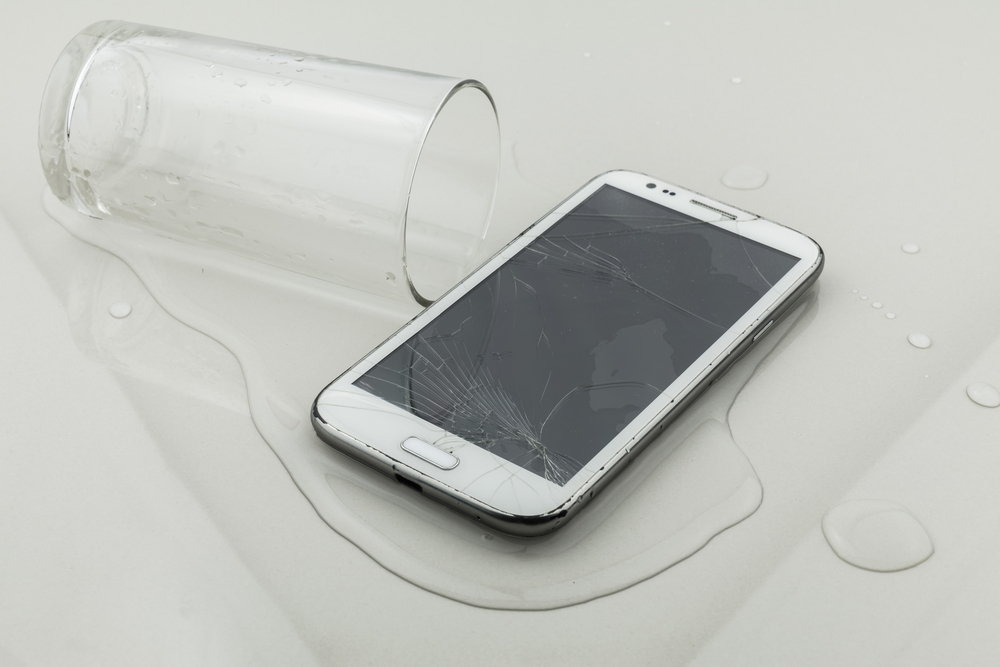
If you suspect your phone has water damage, there are several ways you can check for signs of phone water damage. Here are a few methods to help you determine if your phone has been affected:
- Check the Liquid Damage Indicator (LDI): Most smartphones have a Liquid Damage Indicator, usually located inside the SIM card slot or charging port. The LDI is a small sticker or dot that changes color when it comes into contact with water or moisture. If the LDI has changed color (usually from white to pink, red, or another noticeable color), it shows potential water damage.
- Look for physical signs: Inspect your phone for visible signs of water damage. Look for water droplets under the screen, in the charging port, or behind the battery (if it’s removable). Be on the lookout for corrosion or rust on metal components, such as the SIM card tray or headphone jack.
- Check for unusual behavior: Water damage can cause various malfunctions in your phone. Pay attention to any abnormal behavior, such as random reboots, unresponsive touch screen, distorted audio, or issues with the camera or speakers. If your phone acts strangely after exposure to water, it may indicate water damage.
- Test the functionality: Test all the features and functions of your phone to see if they are working properly. Check the buttons, touch screen, camera, microphone, and speaker. Water damage can disrupt these components, resulting in glitches or complete failure.
- Monitor battery performance: If your phone’s battery drains unusually fast, isn’t holding a charge, or swelling, it could be a sign of water damage. Water exposure can damage the battery or cause it to malfunction, affecting its performance and lifespan. It can also cause it to short circuit, which is a fire risk.
- Check for moisture under the screen: Sometimes, water can seep into the screen and create visible moisture or water droplets trapped between the layers. If you notice foggy patches, water spots, or a moisture-distorted display, it suggests potential water damage.
Remember, water damage can vary in severity, and not all signs may be immediately noticeable. If you suspect water damage or experience any issues after your phone has been exposed to water, it’s advisable to seek professional assistance or contact your phone manufacturer for guidance. They can provide a more accurate assessment and suggest the best course of action to prevent further damage.
What Are the Signs of Water Damage on My iPhone?
The simplest solution to checking your iPhone for signs of water ingress is to check the LDI, as mentioned above. Apple’s iPhone LDI guide to the LDI in iPhones shows that it is located inside the SIM tray. To check it, Apple says you should:
- Open the SIM tray and remove the tray completely.
- Using a torch, look inside the SIM tray, angling the phone slightly, and you will see the LDI (you might also need a small magnifying glass to see the LDI strip).
- If the LDI is red, this is a sign that liquid has entered your smartphone, and you should follow steps to remove the liquid.
What Are the Signs of Water Damage on My Samsung Phone?
As with the iPhone, the best way to find out if your Samsung phone is displaying signs of water damage is to check the LDI. In Samsung’s LDI guide, the LDI is again located inside the SIM tray. To find out if your LDI is indicating water damage, you should:
- Open and remove the SIM tray from its slot. Set your smartphone screen up.
- Again, using a torch and small magnifying glass, look inside the SIM tray.
- If the LDI is showing signs of water damage, it will be a solid square of bright pink. If it is not showing water damage, it will be solid white, or white with X shapes on it.
If I Have a Waterproof or Water Resistant Phone, Can it Get Water Damage?
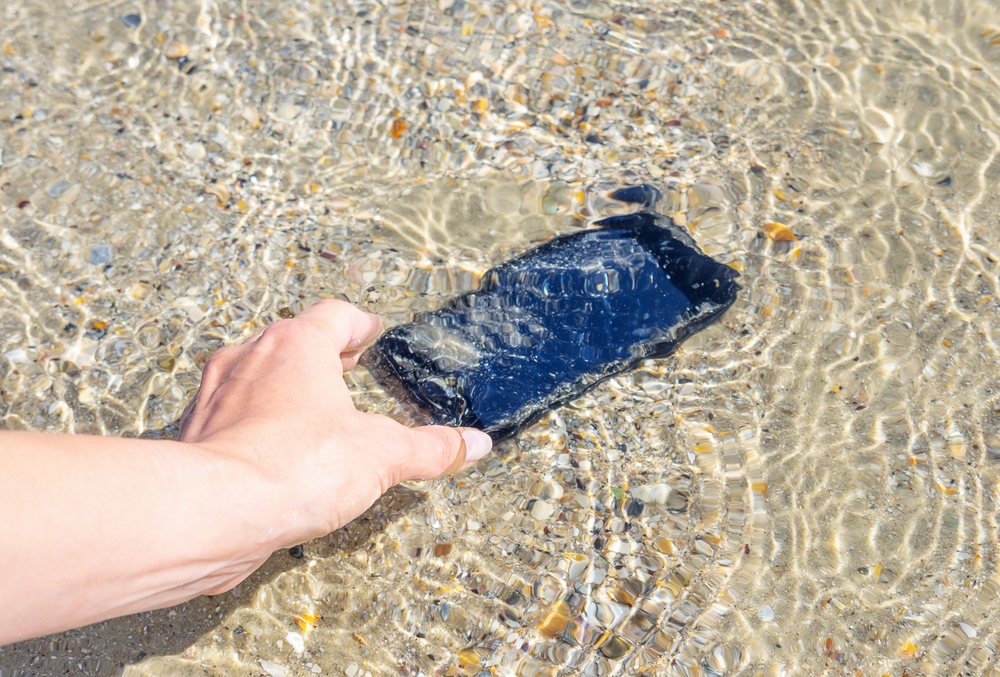
The short answer is “yes, a waterproof or water resistant phone can get water damage”. However, the degree of damage, and the severity of the conditions under which it will succumb to water damage can vary greatly.
One indicator of “how waterproof” your smartphone is, is the IP rating. IP stands for “ingress protection” and is a way of measuring a device’s resistance to the ingress of both dust particles and liquids. The IP rating will be formatted as “IPZY”, where the Z will give a number that denotes ingress protection from solids, and the Y number denotes ingress protection from water. If your phone has no protection from solids, then there will be no number, and instead you’ll see an X symbol.
So, for example, your phone might show that it has an IP68 rating. This means it has a rating of 6 for dust protection and 8 for water resistance. But these numbers are no good to you if you don’t know what they mean. Here is a table that shows you what the numbers in your IP rating mean…
| First Number | Solids Protection | Second Number | Moisture Protection |
|---|---|---|---|
| 0 | No protection. | 0 | No protection. |
| 1 | Protected against solid objects over 50mm, e.g. accidental touch by hands. | 1 | Protected against vertically falling drops of water, e.g. condensation. |
| 2 | Protected against solid objects over 12mm, e.g. fingers. | 2 | Protected against direct sprays of water up to 15 degrees from the vertical. |
| 3 | Protected against solid objects over 2.5mm, e.g. tools & wires. | 3 | Protected against direct sprays of water up to 60 degrees from the vertical. |
| 4 | Protected against solid objects over 1mm, e.g. wires & nails. | 4 | Protected against moderate water splashed from all directions. |
| 5 | Protected against dust, limited ingress, no harmful deposits. | 5 | Protected against low pressure water jets in all directions. |
| 6 | Totally protected against dust. | 6 | Protected against strong jets of water. |
| 7 | Protected from submersion up to one meter in depth, for a duration of up to 30 minutes. | ||
| 8 | Protected from submersion up to three meters in depth, for long periods. |
Degrees of protection provided by enclosures (IP Code)
Even if your smartphone has an IP68 rating, you need to be careful. Drop it in water deeper than three meters, for example, and whether or not you can retrieve it, it is still likely to get show signs of water damage. Drop it in the sea and, thanks to the additional corrosion salt water can cause, your IP rating will be meaningless.
Your IP rating only covers still (as in not moving), pure water, so it doesn’t cover any other liquids like tea or coffee, or a fizzy drink, as these introduce additional factors that can cause damage, like heat (from a hot drink) or corrosive sugars from a fizzy drink.
Lastly, if your phone isn’t in perfect condition, such as having cracks in the screen for example, then this leaves your device even more susceptible to water ingress, as damage of this nature will allow for water to enter via the screen, and cause immediate damage beneath the screen, which you can’t reach to dry out.
Most phones nowadays offer some degree of ingress protection. Many of the flagship devices such as the Apple iPhone 14 Pro Max have an IP68 rating, as do the Samsung Galaxy S23 Ultra, the Honor Magic5 Pro, and the Google Pixel 7 Pro, for example. However, you should always check the IP rating of your smartphone, and never purposefully submerge it in any liquids.
What to Do if You Drop Your Phone in Water?
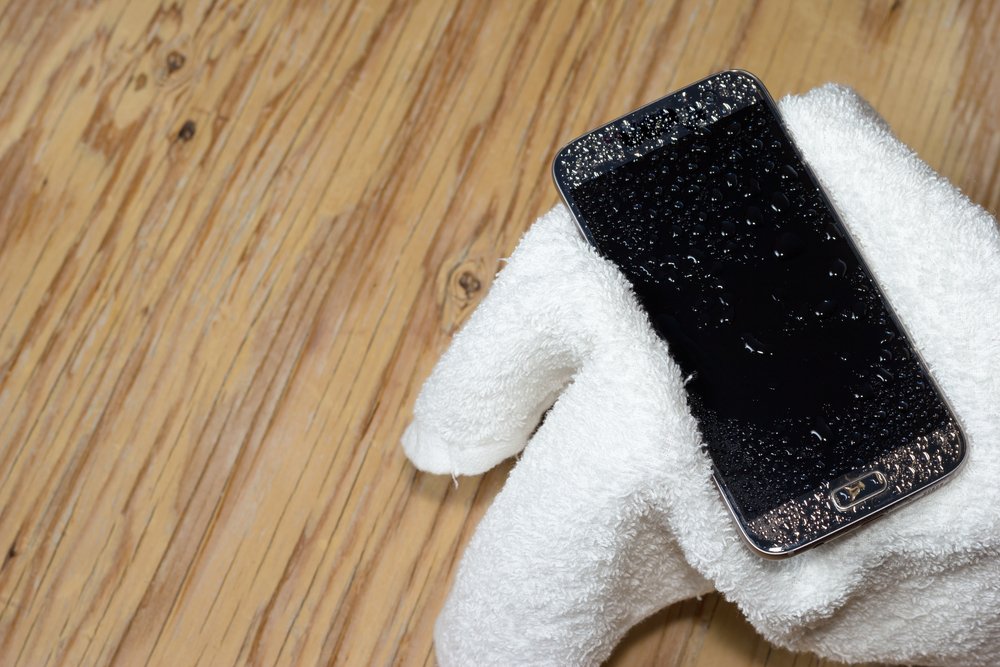
Whether you need to get water out of your iPhone, or you want to get moisture out of your Samsung phone, the steps you can take to reduce the damage of water ingress are the same; it doesn’t matter what operating system you’re using, as this is physical damage, not a software issue.
There are several misconceptions relating to how you should dry a phone that you have accidentally submerged in water, including drying on a radiator, drying it with a hair dryer, and submerging the device in rice. You shouldn’t do any of these things, so we asked a veteran of the industry, Craig Holt—who has over 25 years’ experience in phone repair —to tell us what you need to do to react to water damage…
- Switch the phone off, if you can.
- Remove any protective case and screen protectors (liquid can get trapped behind screen protectors).
- Dry the phone externally with a cloth and give your phone a quick shake to help force any excess liquid out of your ports.
- Keep the phone upright so that any water can drip out of the charging port.
- DO NOT use cotton swabs or any other foreign bodies to attempt to dry the charging port. This might force water further into the device, or leave behind cotton residue. If cotton residue is damp, and stays in the port, it can lead to corrosion.
- Don’t attempt to access the internals if it is a sealed device.
- If the back is removable, remove the battery straight away and dry all visible areas.
- Don’t attempt to charge the device.
- Don’t heat the device to dry it internally, as this can cause further issues.
- Book an appointment with a nearby repair centre that offers liquid damage repairs.
- In the meantime, you can pop your phone in a zip lock/ sandwich bag with some silica gel packs, like those found in shoe boxes. That will help to absorb any moisture while you wait for your appointment. Realistically, only a professional clean will ensure all water is removed.
- Get the device to a reputable repair shop for a liquid damage clean.
Should You Dry Your Device With a Hair Dryer?
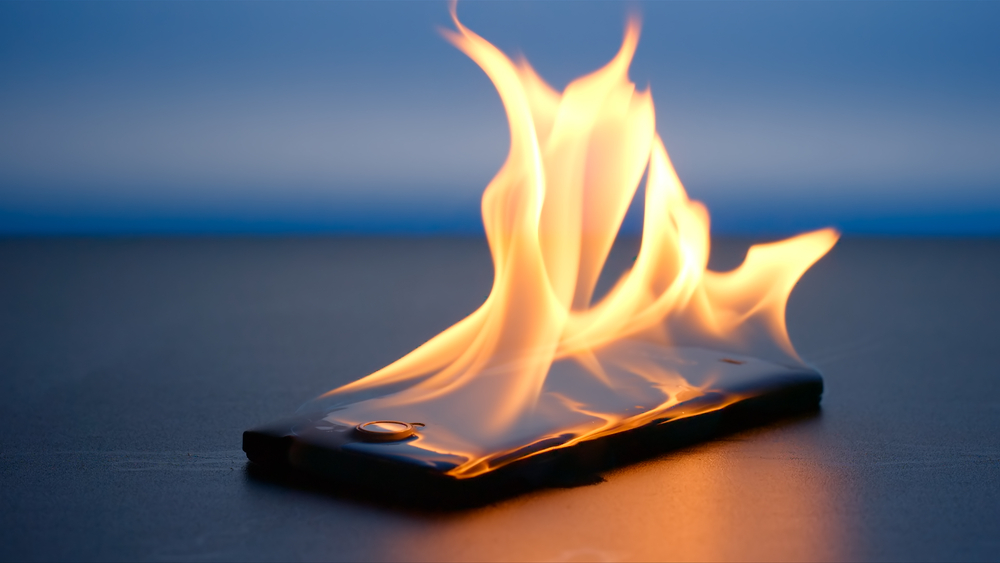
No! You should never do this. Heating the handset can cause further damage, especially if it gets too hot. Overheat your battery and it may swell, which therefore damages the battery itself, and can cause the screen to separate from the rest of the phone. Worse still, it might explode or go on fire, which means your could harm yourself in the process. Using heat will also just turn any water inside the smartphone into condensation, which allows it to spread around the phone, causing corrosion to the internals.
You also shouldn’t attempt to dry your phone using a hairdryer on a cold setting. This can just blow water further into your handset if it is damaged in any other way (like a screen crack) and doesn’t guarantee you’ll remove the moisture from the charging port or headphone port.
Should You Dry Your Device in Rice?
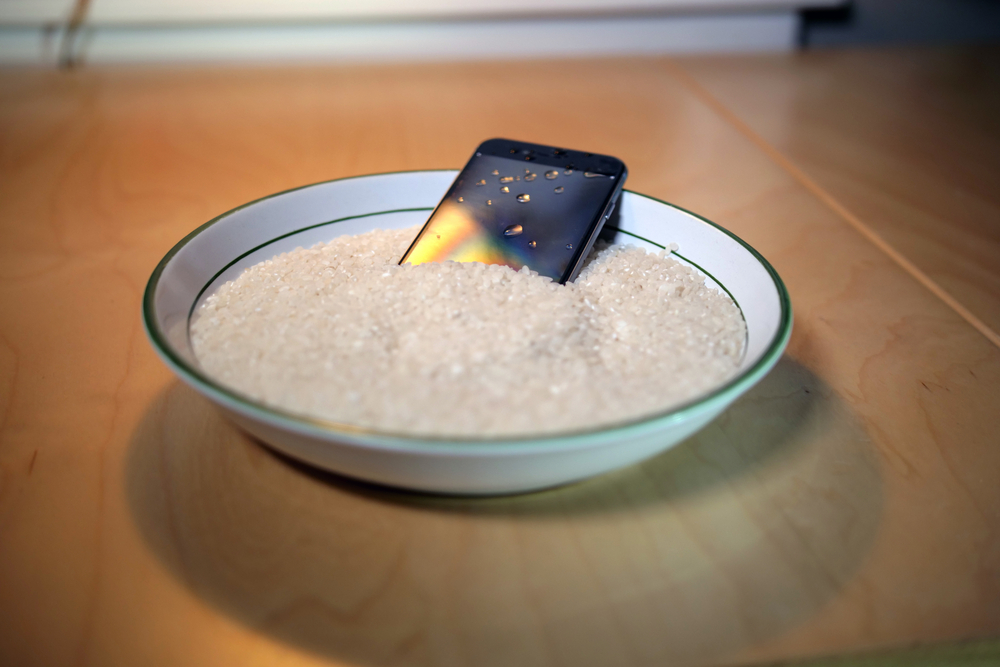
No! Again, do not try this says Sarah McConomy of SellCell. Even Apple has stated that you should never place your phone in rice. It says so on the iPhone water damage warning support page. Placing your smartphone in rice does nothing to remove moisture from the smartphone. Instead, you are introducing particulate that could damage your phone even more. Rice is a well-known source of starch, which may accelerate corrosion around the charging port, for example. Rice dust may even enter the charging port and remain there, damaging the device over time.
You should take your smartphone to a reputable repair professional. They will treat it properly and remove water using tried and tested methods that won’t damage the phone even more. Place the phone in a container with silica gel packs to help draw out any moisture. This will help while you wait to see the repair professional.
Here are the reasons NOT to put your phone in rice if you think it has water damage…
- Ineffectiveness: Placing a phone in rice is often ineffective in fully drying out the device. While rice can absorb some moisture, it’s not powerful enough to remove moisture from all parts of the phone. Especially from hard-to-reach areas like within the circuitry.
- Residue and Dust: Rice can leave behind residue and dust particles inside the phone. This potentially causes further damage to delicate electronic components. This residue can worsen the situation by interfering with the phone’s functionality or causing short circuits.
- Corrosion Risk: Rice does not prevent corrosion. In fact, prolonged exposure to moisture can increase the risk of corrosion within the phone. Corrosion can lead to irreversible damage to the internal components, rendering the device unusable.
- Limited Absorption: Rice’s moisture-absorbing properties are limited compared to other desiccants. Use those specifically designed for electronics, such as silica gel, instead. Using a more effective desiccant can significantly improve the chances of successful drying without causing additional harm to the device.
- Potential Contamination: Rice may introduce contaminants into the phone. These could be starch or other particles, which can further compromise the phone’s functionality. These contaminants may also complicate repair attempts or void warranties.
- Better Alternatives: There are more effective methods available for drying out a wet phone. Try using silica gel packets, employing dedicated electronic drying kits, or seeking professional repair services. These methods are designed to safely and efficiently remove moisture from electronic devices without introducing additional risks.
- Risk of Voiding Warranty: Attempting to dry out a phone with rice may void the manufacturer’s warranty. Manufacturers typically recommend specific procedures for addressing water damage. Failure to follow these guidelines could result in the loss of warranty coverage.
Is Water Damage Repair Possible? How to Fix a Phone With Water Damage
A water damage repair is possible, but this depends on the level of damage from the water, and what parts of the phone have been affected. It will also largely depend on the cost of any replacement parts needed and if repair does indeed make sense.
The recovery of data is also important in a repair. SellCell always recommends backing up your phone regularly. SellCell also states that you should take your device to a repair shop as soon as it experiences liquid damage. Even if it seems to be working okay.
When you take it to a certified technician, they can open the device (even if it’s sealed), check for liquid ingress, damage, or corrosion, and perform a clean. A commonly used cleaning method is isopropyl alcohol as this effectively removes corrosion and signs of liquid ingress without causing damage, as well as displacing any remaining water droplets. Once techs are satisfied that the device is dry and cleaned, they can then check for board and parts damage and quote for additional repairs if necessary.
Does Apple Offer Water Damage Repair?
According to the Apple Support liquid damage page, your warranty does not cover the effects of water damage. This means that Apple doesn’t offer water damage repair as part of its servicing products.
If you have an Apple+ Care Plan, then it is covered by accidental damage, and therefore you can claim a replacement handset at a reduced cost.
If you have a third party insurance policy, then check whether that covers you for accidental damage from water. If it does, you should be able to make a claim.
Does Samsung Offer Water Damage Repair?
Samsung’s liquid damage support page states that, as with the iPhone above, your limited warranty does not cover the effect of accidental damage from water.
If you experience water damage, then you would need to contact the Samsung support center. If you have a Samsung Care+ plan, you can have it serviced or replaced, but this could be at a cost, if indeed Samsung can fix the problem.
Your best chance of repair or replacement is to make sure you have third party insurance that covers accidental damage. Then you can claim against it.
Should You Attempt to Perform a Phone Water-Damage Repair at Home?
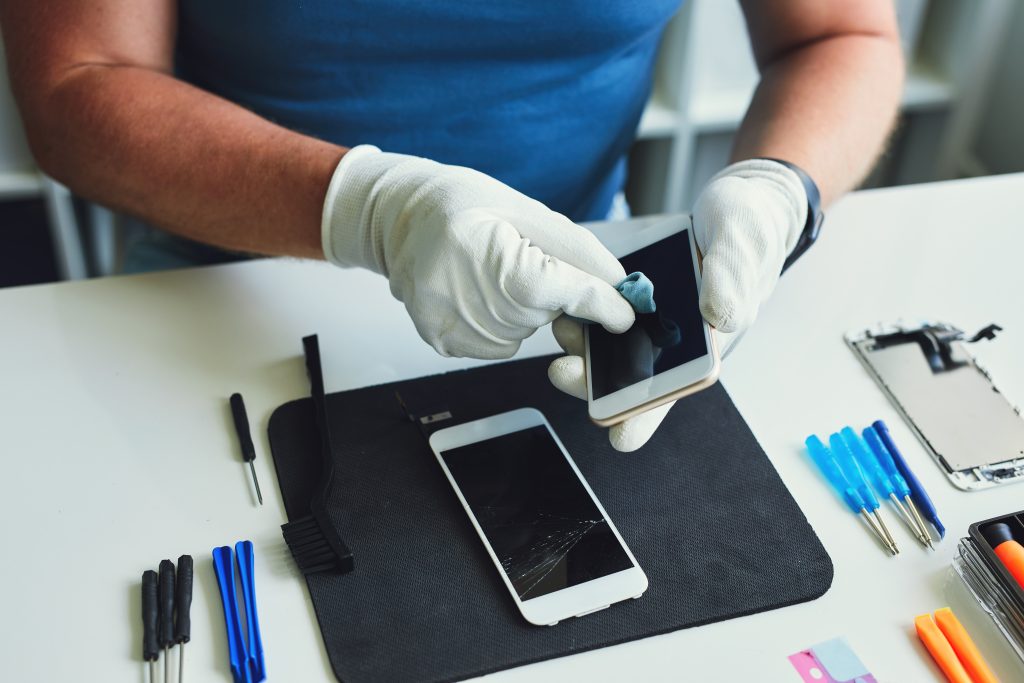
Another thing you should never try yourself, unless you are an expert. To conduct a phone repair for water damage, you would need to break the phone open and reveal the circuitry. Not only is this dangerous (as it may damage the battery in the process, causing it to swell, explode, or go on fire), but it also might void the warranty.
You should only ever have a reputable repair technician attempt to fix your phone for you. They are trained to deal with issues like water ingress, and are more likely to succeed in repairing the phone, or reducing damage, than you are.
Where Can I Find a Reputable Phone Repair Technician?
You can find a reputable phone repair technician by shopping around. Do your research to find out which technicians come with a recommendation from previous customers. You can find this out by using sites like Trustpilot and checking out reviews of the services repair technicians provide. If they’ve helped people in the past, and done a good job, then some of these people will have left reviews on Trustpilot and similar sites.
Can I Claim off Insurance for Liquid Damage Repair for My Phone?
This depends on your insurance policy. You should always select a policy that covers you for accidental damage (in particular liquid damage), as well as loss and theft of your handset. This way, if your smartphone experiences water damage, then you can have it repaired or replaced.
Companies like SquareTrade, AKKO, and Asurion all offer policies that cover your smartphone for liquid damage. Likewise, Apple Care+ and Samsung Care+ also have policies that offer protection for liquid damaged smartphones.
Can I Sell My Phone if it Has Liquid Damage?
The answer is yes, you can, although there are several factors to consider. You can trade your phone in with SellCell, and some of the trusted buyers SellCell works with will consider a phone with water damage. However, the price they give you might not align with what you’re expecting, despite being the best price available online. This is because accepting a water damaged phone is a high risk to a buyer.
It is worth looking into the cost of repairing liquid damage first, including parts and labor. Then compare this with the price one of SellCell’s buyers will offer you for your phone. That way you can decide whether you should have it repaired, or get rid of the handset and buy another one (pro-tip: you could buy a fully-working, refurbished handset from SellCell to replace your liquid damaged phone…).
Tips to Avoid Water Damage in Your Phone
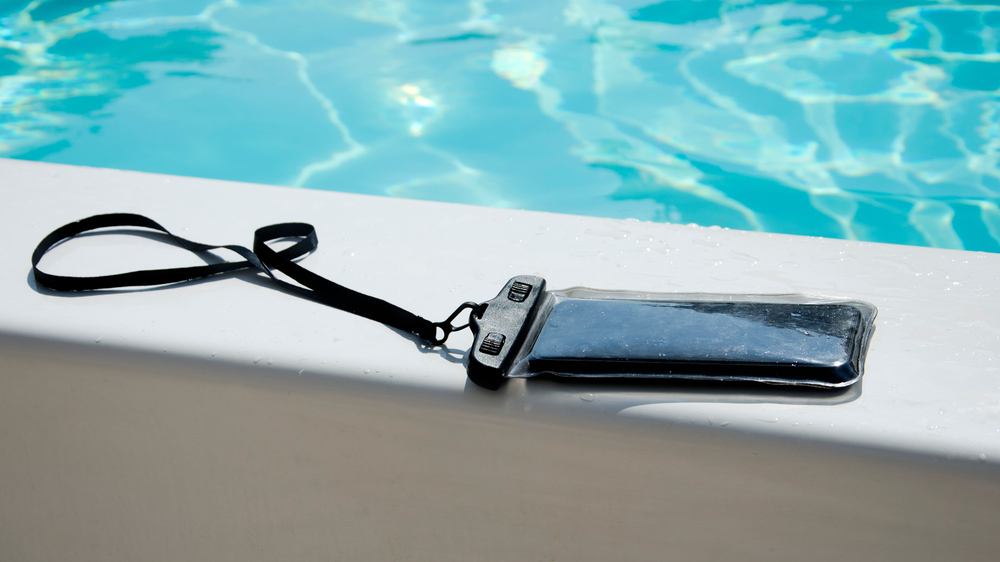
- Ensure your smartphone is equipped with a water-resistant or waterproof rating, indicated by an Ingress Protection (IP) rating, to provide an inherent safeguard against water damage.
- Avoid exposing your smartphone to extreme environmental conditions such as heavy rain, snow, or high humidity, as prolonged exposure might compromise its water resistance.
- Keep your smartphone away from bodies of water, such as pools, lakes, and the ocean, as accidental submersion can cause irreparable damage to internal components.
- Invest in a reliable waterproof smartphone case that provides an additional layer of protection, especially during outdoor activities or in environments prone to water exposure.
- Be cautious when using your smartphone near water sources, such as the bathroom or kitchen, as accidental spills or splashes can quickly infiltrate vulnerable areas and lead to water damage.
- Avoid using your smartphone with wet hands, as moisture can seep into openings like charging ports or headphone jacks, potentially causing internal corrosion or short circuits.
- If your smartphone gets wet, immediately power it off, remove any accessories, and gently dry it using a soft cloth. Avoid using heat sources, as they can further damage the device.
- Consider using water-absorbing packets or silica gel packs in areas where you store your smartphone, as they can help absorb excess moisture and reduce the risk of water damage.
- Regularly inspect your smartphone for any signs of wear or damage to its water-resistant features, such as cracked screens, loose seals, or damaged charging ports, and promptly address any issues with professional help.
- Backup your smartphone data regularly to ensure you can quickly recover your information in case of water damage or the need for repairs, minimizing potential data loss.
- Buy a rugged “burner” smartphone. If you know you’re going somewhere that your smartphone will come into contact with moisture, then a rugged smartphone will provide better protection (plus you’ll be protected against other negative effects that can damage a smartphone). Brands like Doogee make great rugged handsets, and they’re often very affordable; it might even be cheaper to buy one than repairing your iPhone 14 Pro Max!
Liquid Damaged Smartphone? SellCell Has You Covered
Now you should know exactly what (and what not) to do if your smartphone experiences water damage. Never attempt to fix it yourself unless you’re a professional. If you’re not a professional, take your handset to one. This way, you have the best chance of getting your phone fixed.
If it is going to cost too much, consider selling your handset to one of SellCell’s trusted buyback vendors, and then buy a refurbished handset from SellCell at a fraction of the MSRP. You might find your save money vs. a repair, and you could even have some change for a proper waterproof case!
